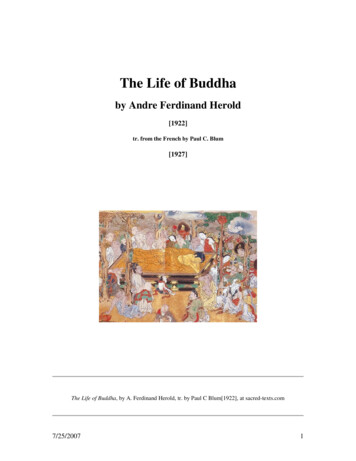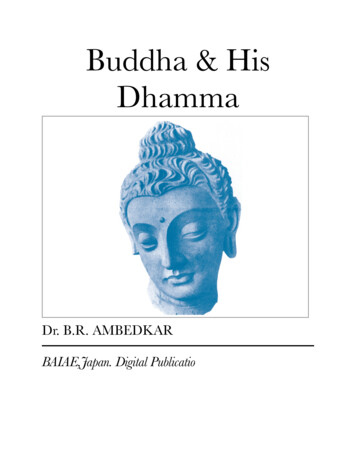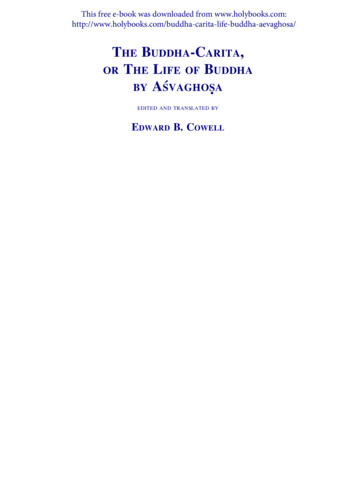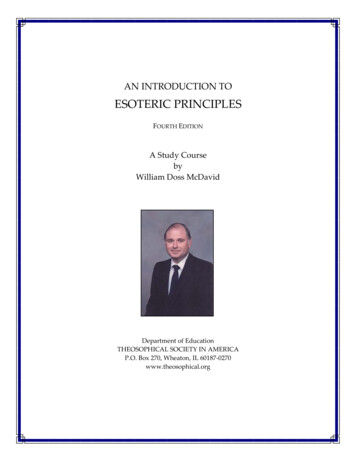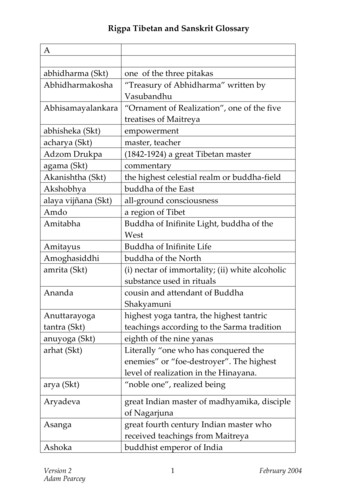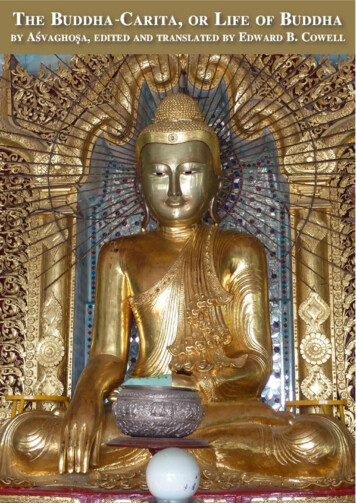
Transcription
In theBuddha'sWordsAn Anthology of Discoursesfrom the Pali CanonEdited and introduced byBhikkhu BodhiTamed, he is supreme among those who tame;At peace, he is the sage among those who bring peace;Freed, he is the chief of those who set free;Delivered, he is the best of those who deliver.—Anguttara Nikaya 4:23WISDOM PUBLICATIONS BOSTON
Wisdom Publications, Inc.199 Elm StreetSomerville MA 02144 USAwww.wisdompubs .orgCONTENTS 2005 Bhikkhu BodhiAll rights reserved.ForewordAll rights reserved. No part of this publication may be reproduced, stored in aretrieval system or transmitted in any form by any means without the prior permission of the copyright owner. Enquiries should be made to the publisher.Library of Congress Cataloging-in-Publication DataTipitaka. Suttapitaka. English. Selections.In the Buddha's words : an anthology of discourses from the Pali canon /edited and introducedby Bhikkhu Bodhi. — 1st ed.p. cm.Includes bibliographical references and indexes.ISBN 0-86171-491-1 (pbk.: alk. paper)I. Bodhi, Bhikkhu. II. Title.BQ1192.E53B63 2005294.3'823 dc222005018336ISBN 0-86171-491-1Second Printing09 08 075 4 3The publisher thanks AltaMira Press for kindly granting permission to include in thisanthology selections from Numerical Discourses of the Buddha: An Anthology ofSuttasfrom the Anguttara Nikaya, translated and edited by Nyanaponika Thera and BhikkhuBodhi.PrefaceList of AbbreviationsKey to the Pronunciation of PaliDetailed List of ContentsGeneral IntroductionI. The Human ConditionII. The Bringer of LightIII. Approaching the DhammaIV. The Happiness Visible in This Present LifeV The Way to a Fortunate RebirthVI. Deepening One's Perspective on the WorldVII. The Path to LiberationVIII. Mastering the MindIX. Shining the Light of WisdomX. The Planes of RealizationY[[}xx ivxvX vii\YJ4179105143181221255299371Cover and interior design by Gopa&Ted2, Inc. Set in DPalatino 10/13.75 pt.Frontispiece: Standing Buddha Shakyamuni. Pakistan, Gandhara, second century A.D.Height 250cm. Courtesy of the Miho Museum, Japan, www.miho.jpWisdom Publications' books are printed on acid-free paper and meet the guidelinesfor permanence and durability set by the Council of Library Resources.Printed in the United States of America.mf » This book was produced with environmental mindfulness. We have elected to W print this title on 50% PCW recycled paper. As a result, we have saved the following resources: 65 trees, 45 million BTUs of energy, 5,715 lbs. of greenhouse gases, 23,722gallons of water, and 3,046 lbs. of solid waste. For more information, please visit ourwebsite, www.wisdompubs.orgNotes425Table of Sources459Glossary459Bibliography471Index of Subjects473Index of Proper Names479Index of Similes48 \Index of Selected Pali Sutta Titles483Index of Pali Terms Discussed in the Notes485
FOREWORDMore than two thousand five hundred years havekind teacher, Buddha Sakyamuni, taught in India. Hiall who wished to heed it, inviting them to listen, refexamine what he had to say. He addressed differengroups of people over a period of more than forty yAfter the Buddha's passing, a record of what he saias an oral tradition. Those who heard the teachings v\meet with others for communal recitations of what trmemorized. In due course, these recitations from mten down, laying the basis for all subsequent BuddlPali Canon is one of the earliest of these written reccomplete early version that has survived intact. Withthe texts known as the Nikayas have the special valgle cohesive collection of the Buddha's teachings i:These teachings cover a wide range of topics; they crenunciation and liberation, but also with the orooer
viiiIn the Buddha's Wordstransport and communication that I most appreciate is the vastlyexpanded opportunities those interested in Buddhism now have toacquaint themselves with the full range of Buddhist teaching and practice. What I find especially encouraging about this book is that it showsso clearly how much fundamentally all schools of Buddhism have incommon. I congratulate Bhikkhu Bodhi for this careful work of compilation and translation. I offer my prayers that readers may findadvice here—and the inspiration to put it into practice—that willenable them to develop inner peace, which I believe is essential for thecreation of a happier and more peaceful world.Venerable Tenzin Gyatso, the Fourteenth Dalai LamaMay 10,2005PREFACEThe Buddha's discourses preserved in the Pali Canon are called suttas,the Pali equivalent of the Sanskrit word sutras. Although the PaliCanon belongs to a particular Buddhist school—the Theravada, orSchool of the Elders—the suttas are by no means exclusivelyTheravada Buddhist texts. They stem from the earliest period ofBuddhist literary history, a period lasting roughly a hundred yearsafter the Buddha's death, before the original Buddhist communitydivided into different schools. The Pali suttas have counterparts fromother early Buddhist schools now extinct, texts sometimes strikinglysimilar to the Pali version, differing mainly in settings and arrangements but not in points of doctrine. The suttas, along with their counterparts, thus constitute the most ancient records of the Buddha'steachings available to us; they are the closest we can come to what thehistorical Buddha Gotama himself actually taught. The teachingsfound in them have served as the fountainhead, the primal source, forall the evolving streams of Buddhist doctrine and practice through thecenturies. For this reason, they constitute the common heritage of theentire Buddhist tradition, and Buddhists of all schools who wish tounderstand the taproot of Buddhism should make a close and carefulstudy of them a priority.In the Pali Canon the Buddha's discourses are preserved in collections called Nikayas. Over the past twenty years, fresh translations ofthe four major Nikayas have appeared in print, issued in attractiveand affordable editions. Wisdom Publications pioneered this development in 1987 when it published Maurice Walshe's translation of theDigha Nikaya, The Long Discourses of the Buddha. Wisdom followedthis precedent by bringing out, in 1995, my revised and edited version of Bhikkhu Nanamoli's handwritten translation of the MajjhimaNikaya, The Middle Length Discourses of the Buddha, followed in 2000 bymy new translation of the complete Samyutta Nikaya, The ConnectedDiscourses of the Buddha. In 1999, under the imprint of The Sacred Literature Trust Series, AltaMira Press published an anthology of suttasix
xIn the Buddha's Wordsfrom the Ahguttara Nikaya, translated by the late Nyanaponika Theraand myself, titled Numerical Discourses of the Buddha. I am currentlyworking on a new translation of the entire Ahguttara Nikaya, intendedfor Wisdom Publication's Teachings of the Buddha series.Many who have read these larger works have told me, to my satisfaction, that the translations brought the suttas to life for them. Yetothers who earnestly sought to enter the deep ocean of the Nikayastold me something else. They said that while the language of the translations made them far more accessible than earlier translations, theywere still grappling for a standpoint from which to see the suttas'overall structure, a framework within which they all fit together. TheNikayas themselves do not offer much help in this respect, for theirarrangement—with the notable exception of the Samyutta Nikaya,which does have a thematic structure—appears almost haphazard.In an ongoing series of lectures I began giving at Bodhi Monasteryin New Jersey in January 2003,1 devised a scheme of my own to organize the contents of the Majjhima Nikaya. This scheme unfolds theBuddha's message progressively, from the simple to the difficult, fromthe elementary to the profound. Upon reflection, I saw that this schemecould be applied not only to the Majjhima Nikaya, but to the fourNikayas as a whole. The present book organizes suttas selected from allfour Nikayas within this thematic and progressive framework.This book is intended for two types of readers. The first are thosenot yet acquainted with the Buddha's discourses who feel the need fora systematic introduction. For such readers, any of the Nikayas isbound to appear opaque. All four of them, viewed at once, may seemlike a jungle—entangling and bewildering, full of unknown beasts—orlike the great ocean—vast, tumultuous, and forbidding. I hope thatthis book will serve as a map to help them wend their way through thejungle of the suttas or as a sturdy ship to carry them across the oceanof the Dhamma.The second type of readers for whom this book is meant are those,already acquainted with the suttas, who still cannot see how they fittogether into an intelligible whole. For such readers, individual suttas may be comprehensible in themselves, but the texts in their totality appear like pieces of a jigsaw puzzle scattered across a table. Onceone understands the scheme in this book, one should come away witha clear idea of the architecture of the teaching. Then, with a littlePreface xireflection, one should be able to determine the place any sutta occupies in the edifice of the Dhamma, whether or not it has been includedin this anthology.This anthology, or any other anthology of suttas, is no substitutefor the Nikayas themselves. My hope is twofold, corresponding to thetwo types of readers for whom this volume is designed: (1) that newcomers to Early Buddhist literature find this volume whets theirappetite for more and encourages them to take the plunge into thefull Nikayas; and (2) that experienced readers of the Nikayas finish thebook with a better understanding of material with which they arealready familiar.If this anthology is meant to make any other point, it is to convey thesheer breadth and range of the Buddha's wisdom. While EarlyBuddhism is sometimes depicted as a discipline of world renunciationintended primarily for ascetics and contemplatives, the ancient discourses of the Pali Canon clearly show us how the Buddha's wisdomand compassion reached into the very depths of mundane life, providing ordinary people with guidelines for proper conduct and rightunderstanding. Far from being a creed for a monastic elite, ancientBuddhism involved the close collaboration of householders andmonastics in the twin tasks of maintaining the Buddha's teachings andassisting one another in their efforts to walk the path to the extinctionof suffering. To fulfill these tasks meaningfully, the Dhamma had toprovide them with deep and inexhaustible guidance, inspiration, joy,and consolation. It could never have done this if it had not directlyaddressed their earnest efforts to combine social and family obligations with an aspiration to realize the highest.Almost all the passages included in this book have been selected fromthe above-mentioned publications of the four Nikayas. Almost all haveundergone revisions, usually slight but sometimes major, to accord withmy own evolving understanding of the texts and the Pali language. Ihave newly translated a small number of suttas from the AhguttaraNikaya not included in the above-mentioned anthology. I have alsoincluded a handful of suttas from the Udana and Itivuttaka, two smallbooks belonging to the fifth Nikaya, the Khuddaka Nikaya, the Minoror Miscellaneous Collection. I have based these on John D. Ireland'stranslation, published by the Buddhist Publication Society in Sri Lanka,but again I have freely modified them to fit my own preferred diction
xiiIn the Buddha's Wordsand terminology. I have given preference to suttas in prose over thosein verse, as being more direct and explicit. When a sutta concludeswith verses, if these merely restate the preceding prose, in the interestof space I have omitted them.Each chapter begins with an introduction in which I explain thesalient concepts relevant to the theme of the chapter and try to showhow the texts I have chosen exemplify that theme. To clarify pointsarising from both the introductions and the texts, I have included endnotes. These often draw upon the classical commentaries to theNikayas ascribed to the great South Indian commentator AcariyaBuddhaghosa, who worked in Sri Lanka in the fifth century C.E. For thesake of concision, I have not included as many notes in this book as Ihave in my other translations of the Nikayas. These notes are also notas technical as those in the full translations.References to the sources follow each selection. References to textsfrom the Digha Nikaya and Majjhima Nikaya cite the number andname of the sutta (in Pali); passages from these two collections retainthe paragraph numbers used in The Long Discourses of the Buddha andThe Middle Length Discourses of the Buddha, so readers who wish tolocate these passages within the full translations can easily do so. References to texts from the Samyutta Nikaya cite samyutta and sutta number; texts from the Ahguttara Nikaya cite nipata and sutta number (theOnes and the Twos also cite chapters within the nipata followed by thesutta number). References to texts from the Udana cite nipata and suttanumber; texts from the Itivuttaka cite simply the sutta number. All references are followed by the volume and page number in the Pali TextSociety's standard edition of these works.I am grateful to Timothy McNeill and David Kittelstrom of WisdomPublications for urging me to persist with this project in the face of longperiods of indifferent health. Samanera Analayo and Bhikkhu Nyanasobhano read and commented on my introductions, and John Kellyreviewed proofs of the entire book. All three made useful suggestions,for which I am grateful. John Kelly also prepared the table of sourcesthat appears at the back of the book. Finally, I am grateful to my students of Pali and Dhamma studies at Bodhi Monastery for their enthusiastic interest in the teachings of the Nikayas, which inspired me tocompile this anthology. I am especially thankful to the monastery'sextraordinary founder, Ven. Master Jen-Chun, for welcoming a monk ofPreface xiiianother Buddhist tradition to his monastery and for his interest inbridging the Northern and Southern transmissions of the EarlyBuddhist teachings.Bhikkhu Bodhi
LIST OF ABBREVIATIONSKEY T O T H E P R O N U N C I A T I O N O F P A L IANBeCeDNEeItMNAhguttara NikayaBurmese-script Chattha Sahgayana ed.Sinhala-script ed.Digha NikayaRoman-script ed. (PTS)ItivuttakaMajjhima NikayaThe Pali AlphabetMpPpnPsPs-ptManorathapurani (Ahguttara Nikaya Commentary)Path of Purification (Visuddhimagga translation)Papancasudani (Majjhima Nikaya Commentary)Papancasudani-purana-tika (Majjhima NikayaSubcommentary)SanskritSamyutta NikayaSaratthappakasini (Samyutta Nikaya Commentary)Saratthappakasini-purana-tika (Samyutta NikayaSubcommentary)Sumahgalavilasini (Digha Nikaya kSpk-ptSvUdVibhVinVismAll page references to Pali texts are to the page numbers of the PaliText Society's editions.xivVowels: a, a, i, i, u, u, e, lsOtherk, kh, g, gh, hc, ch, j, jh, nt, th, d, dh, nt, th, d, dh, np, ph, b, bh, my, r, 1,1, v, s, h, mPronunciationa as in "cut"a as in "father"i as in "king"i as in "keen"u as in "put"u as in "rule"e as in "way"o as in "home"Of the vowels, e and o are long before a single consonant and shortbefore a double consonant. Among the consonants, g is always pronounced as in "good," c as in "church," n as in "onion." The cerebrals(or retroflexes) are spoken with the tongue on the roof of the mouth;the dentals with the tongue on the upper teeth. The aspirates—kh, gh,ch, jh, th, dh, th, dh, ph, bh—are single consonants pronounced withslightly more force than the nonaspirates, e.g., th as in "Thomas" (notas in "thin"); ph as in "putter" (not as in "phone"). Double consonantsare always enunciated separately, e.g., dd as in "mad dog," gg as in"big gun." The pure nasal (niggahita) m is pronounced like the ng in"song." An o and an e always carry a stress; otherwise the stress fallson a long vowel—a, i, u,—or on a double consonant, or on m.XV
DETAILED LIST OF CONTENTSI. THE H U M A N CONDITIONIntroduction1. Old Age, Illness, and Death(1) Aging and Death (SN 3:3)(2) The Simile of the Mountain (SN 3:25)(3) The Divine Messengers (from AN 3:35)2. The Tribulations of Unreflective Living(1) The Dart of Painful Feeling (SN 36:6)(2) The Vicissitudes of Life (AN 8:6)(3) Anxiety Due to Change (SN 22:7)3. A World in Turmoil(1) The Origin of Conflict (AN 2: iv, 6, abridged)(2) Why Do Beings Live in Hate? (from DN 21)(3) The Dark Chain of Causation (from DN 15)(4) The Roots of Violence and Oppression (from4. Without Discoverable Beginning(1) Grass and Sticks (SN 15:1)(2) Balls of Clay (SN 15:2)(3) The Mountain (SN 15:5)(4) The River Ganges (SN 15:8)(5) Dog on a Leash (SN 22:99)II. T H E B R I N G E R O F L I G H TIntroduction1. One Person (AN Lxiii, 1, 5, 6)xvii
xviiiIn the Buddha's Words2. The Buddha's Conception and Birth (MN 123, abridged)Detailed List of Contents xix503. The Quest for Enlightenment(1) Seeking the Supreme State of Sublime Peace(from MN 26)5459(3) The Ancient City (SN 12:65)674. The Decision to Teach (from MN 26)695. The First Discourse (SN 56:11)75III. A P P R O A C H I N G T H E D H A M M AIntroduction1244. Right Livelihood(2) The Realization of the Three True Knowledges(from MN 36)3. Present Welfare, Future Welfare (AN 8:54)81(1) Avoiding Wrong Livelihood (AN 5:177)126(2) The Proper Use of Wealth (AN 4:61)126(3) A Family Man's Happiness (AN 4:62)1275. The Woman of the Home (AN 8:49)1286. The Community(1) Six Roots of Dispute (from MN 104)130(2) Six Principles of Cordiality (from MN 104)131(3) Purification Is for All Four Castes (MN 93, abridged)132(4) Seven Principles of Social Stability (from DN 16)1371. Not a Secret Doctrine (AN 3:129)88(5) The Wheel-Turning Monarch (from DN 26)1392. No Dogmas or Blind Belief (AN 3:65)88(6) Bringing Tranquillity to the Land (from DN 5)1413. The Visible Origin and Passing Away of Suffering (SN 42:11)914. Investigate the Teacher Himself (MN 47)93V. T H E W A Y TO A F O R T U N A T E R E B I R T H5. Steps toward the Realization of Truth (from MN 95)96Introduction1451. The Law of KammaIV THE H A P P I N E S S VISIBLE IN THIS PRESENT LIFEIntroduction1071. Upholding the Dhamma in Society(1) Four Kinds of Kamma (AN 4:232)155(2) Why Beings Fare as They Do after Death (MN 41)156(3) Kamma and Its Fruits (MN 135)161(1) The King of the Dhamma (AN 3:14)1152. Merit: The Key to Good Fortune(2) Worshipping the Six Directions (from DN 31)116(1) Meritorious Deeds (It 22)166(2) Three Bases of Merit (AN 8:36)167(3) The Best Kinds of Confidence (AN 4:34)1682. The Family(1) Parents and Children(a) Respect for Parents (AN 4:63)(b) Repaying One's Parents (AN 2: iv, 2)(2) Husbands and Wives1181193. Giving(1) If People Knew the Result of Giving (It 26)169(2) Reasons for Giving (AN 8:33)169(a) Different Kinds of Marriages (AN 4:53)119(3) The Gift of Food (AN 4:57)170(b) How to Be United in Future Lives (AN 4:55)121(4) A Superior Person's Gifts (AN 5:148)170(c) Seven Kinds of Wives (AN 7:59)122(5) Mutual Support (It 107)171
xxIn the Buddha's Words(6) Rebirth on Account of Giving (AN 8:35)Detailed List of Contents1714. Moral Discipline172(2) The Uposatha Observance (AN 8:41)1745. Meditation(1) The Development of Loving-Kindness (It 27)176(2) The Four Divine Abodes (from MN 99)177(3) Insight Surpasses All (AN 9:20, abridged)178VI. D E E P E N I N G O N E ' S P E R S P E C T I V E O N T H E W O R L DIntroduction1. Four Wonderful Things (AN 4:128)1831912. Gratification, Danger, and Escape192(2) I Set Out Seeking (AN 3:101 §3)192(3) If There Were No Gratification (AN 3:102)1931934. The Pitfalls in Sensual Pleasures(1) Cutting Off All Affairs (from MN 54)199(2) The Fever of Sensual Pleasures (from MN 75)2025. Life Is Short and Fleeting (AN 7:70)2066. Four Summaries of the Dhamma (from MN 82)2077. The Danger in Views(1) A Miscellany on Wrong View (AN 1: xvii, 1, 3, 7, 9)213(2) The Blind Men and the Elephant (Ud 6:4)214(3) Held by Two Kinds of Views (It 49)2158. From the Divine Realms to the Infernal (AN 4:125)2231. Why Does One Enter the Path?(1) The Arrow of Birth, Aging, and Death (MN 63)230(2) The Heartwood of the Spiritual Life (MN 29)233(3) The Fading Away of Lust (SN 45:41-48, combined)2382. Analysis of the Eightfold Path (SN 45:8)2393. Good Friendship (SN 45:2)2404. The Graduated Training (MN 27)2415. The Higher Stages of Training with Similes (from MN 39)250VIII.MASTERING THE M I N DIntroduction(1) Before My Enlightenment (AN 3:101 §§1-2)3. Properly Appraising Objects of Attachment (MN 13)VII. T H E P A T H T O L I B E R A T I O NIntroduction(1) The Five Precepts (AN 8:39)xxi1. The Mind Is the Key (AN 1: iii, 1, 2, 3, 4, 9,10)2572672. Developing a Pair of Skills(1) Serenity and Insight (AN 2: iii, 10)267(2) Four Ways to Arahantship (AN 4:170)268(3) Four Kinds of Persons (AN 4:94)2693. The Hindrances to Mental Development (SN 46:55, abridged) 2704. The Refinement of the Mind (AN 3:100 §§1-10)2735. The Removal of Distracting Thoughts (MN 20)2756. The Mind of Loving-Kindness (from MN 21)2787. The Six Recollections (AN 6:10)2798. The Four Establishments of Mindfulness (MN 10)2819. Mindfulness of Breathing (SN 54:13)29010. The Achievement of Mastery (SN 28:1-9, combined)296216IX. S H I N I N G T H E L I G H T O F W I S D O M9. The Perils of Samsara(1) The Stream of Tears (SN 15:3)218(2) The Stream of Blood (SN 15:13)219Introduction1. Images of Wisdom301
xxiiIn the Buddha's WordsDetailed List of Contentsxxm(1) Wisdom as a Light (AN 4:143)321(2) Wisdom as a Knife (from MN 146)321(a) The Truths of All Buddhas (SN 56:24)3592. The Conditions for Wisdom (AN 8:2, abridged)322(b) These Four Truths Are Actual (SN 56:20)3593. A Discourse on Right View (MN 9)323(c) A Handful of Leaves (SN 56:31)360(d) Because of Not Understanding (SN 56:21)361(e) The Precipice (SN 56:42)361(f) Making the Breakthrough (SN 56:32)362(g) The Destruction of the Taints (SN 56:25)3634. The Domain of Wisdom(1) By Way of the Five Aggregates(a) Phases of the Aggregates (SN 22:56)335(b) A Catechism on the Aggregates (SN 22:82 MN 109, abridged)338(5) By Way of the Four Noble Truths5. The Goal of Wisdom(c) The Characteristic of Nonself (SN 22:59)341(1) What is Nibbana? (SN 38:1)364(d) Impermanent, Suffering, Nonself (SN 22:45)342(e) A Lump of Foam (SN 22:95)343(2) Thirty-Three Synonyms for Nibbana (SN 43:1-44,combined)364(3) There Is That Base (Ud 8:1)365(2) By Way of the Six Sense Bases(a) Full Understanding (SN 35:26)345(4) The Unborn (Ud 8:3)366(b) Burning (SN 35:28)(c) Suitable for Attaining Nibbana (SN 35:147-49,combined)346(5) The Two Nibbana Elements.(It 44)366346(6) The Fire and the Ocean (from MN 72)367(d) Empty Is the World (SN 35:85)347X. T H E P L A N E S OF R E A L I Z A T I O N(e) Consciousness Too Is Nonself (SN 35:234)348Introduction(3) By Way of the Elements3731. The Field of Merit for the World(a) The Eighteen Elements (SN 14:1)349(1) Eight Persons Worthy of Gifts (AN 8:59)385(b) The Four Elements (SN 14:37-39, combined)349(2) Differentiation by Faculties (SN 48:18)385(c) The Six Elements (from MN 140)350(3) In the Dhamma Well Expounded (from MN 22)386(4) The Completeness of the Teaching (from MN 73)386(5) Seven Kinds of Noble Persons (from MN 70)390(4) By Way of Dependent Origination(a) What Is Dependent Origination? (SN 12:1)353(b) The Stableness of the Dhamma (SN 12:20)353(c) Forty-Four Cases of Knowledge (SN 12:33)355(1) The Four Factors Leading to Stream-Entry (SN 55:5)392(d) A Teaching by the Middle (SN 12:15)356(2) Entering the Fixed Course of Rightness (SN 25:1)393(e) The Continuance of Consciousness (SN 12:38)357(3) The Breakthrough to the Dhamma (SN 13:1)394(f) The Origin and Passing of the World (SN 12:44)358(4) The Four Factors of a Stream-Enterer (SN 55:2)3942. Stream-Entry
xxivIn the Buddha's Words(5) Better than Sovereignty over the Earth (SN 55:1)3953. Nonreturning(1) Abandoning the Five Lower Fetters (from MN 64)396(2) Four Kinds of Persons (AN 4:169)398(3) Six Things that Partake of True Knowledge (SN 55:3)400(4) Five Kinds of Nonreturners (SN 46:3)4014. TheArahant(1) Removing the Residual Conceit "I Am" (SN 22:89)402(2) The Trainee and the Arahant (SN 48:53)406(3) A Monk Whose Crossbar Has Been Lifted (from MN 22)407(4) Nine Things an Arahant Cannot Do (from AN 9:7)408(5) A Mind Unshaken (from AN 9:26)408(6) The Ten Powers of an Arahant Monk (AN 10:90)409(7) The Sage at Peace (from MN 140)410(8) Happy Indeed Are the Arahants (from SN 22:76)4125. TheTathagata(1) The Buddha and the Arahant (SN 22:58)413(2) For the Welfare of Many (It 84)414(3) Sariputta's Lofty Utterance (SN 47:12)415(4) The Powers and Grounds of Self-Confidence(from MN 12)417(5) The Manifestation of Great Light (SN 56:38)419(6) The Man Desiring Our Good (from MN 19)(7) The Lion (SN 22:78)420420(8) Why Is He Called the Tathagata? (AN 4:23 It 112)421GENERAL INTRODUCTIONUNCOVERING THE STRUCTURE OF THE TEACHINGThough his teaching is highly systematic, there is no single text that canbe ascribed to the Buddha in which he defines the architecture of theDhamma, the scaffolding upon which he has framed his specificexpressions of the doctrine. In the course of his long ministry, theBuddha taught in different ways as determined by occasion and circumstances. Sometimes he would enunciate invariable principles thatstand at the heart of the teaching. Sometimes he would adapt the teaching to accord with the proclivities and aptitudes of the people whocame to him for guidance. Sometimes he would adjust his expositionto fit a situation that required a particular response. But throughoutthe collections of texts that have come down to us as authorized "Wordof the Buddha," we do not find a single sutta, a single discourse, inwhich the Buddha has drawn together all the elements of his teachingand assigned them to their appropriate place within some comprehensive system.While in a literate culture in which systematic thought is highlyprized the lack of such a text with a unifying function might be viewedas a defect, in an entirely oral culture—as was the culture in which theBuddha lived and moved—the lack of a descriptive key to theDhamma would hardly be considered significant. Within this cultureneither teacher nor student aimed at conceptual completeness. Theteacher did not intend to present a complete system of ideas; his pupilsdid not aspire to learn a complete system of ideas. The aim that unitedthem in the process of learning—the process of transmission—was thatof practical training, self-transformation, the realization of truth, andunshakable liberation of the mind. This does not mean, however, thatthe teaching was always expediently adapted to the situation at hand.At times the Buddha would present more panoramic views of theDhamma that united many components of the path in a graded orwide-ranging structure. But though there are several discourses that1
2In the Buddha's Wordsexhibit a broad scope, they still do not embrace all elements of theDhamma in one overarching scheme.The purpose of the present book is to develop and exemplify such ascheme. I here attempt to provide a comprehensive picture of theBuddha's teaching that incorporates a wide variety of suttas into anorganic structure. This structure, I hope, will bring to light the intentional pattern underlying the Buddha's formulation of the Dhammaand thus provide the reader with guidelines for understanding EarlyBuddhism as a whole. I have selected the suttas almost entirely fromthe four major collections or Nikayas of the Pali Canon, though I havealso included a few texts from the Udana and Itivuttaka, two smallbooks of the fifth collection, the Khuddaka Nikaya. Each chapter openswith its own introduction, in which I explain the basic concepts ofEarly Buddhism that the texts exemplify and show how the texts giveexpression to these ideas.I will briefly supply background information about the Nikayas laterin this introduction. First, however, I want to outline the scheme that Ihave devised to organize the suttas. Although my particular use of thisscheme may be original, it is not sheer innovation but is based upon athreefold distinction that the Pali commentaries make among the typesof benefits to which the practice of the Dhamma leads: (1) welfare andhappiness visible in this present life; (2) welfare and happiness pertaining to future lives; and (3) the ultimate good, Nibbana (Skt: nirvana).Three preliminary chapters are designed to lead up to those thatembody this threefold scheme. Chapter I is a survey of the human condition as it is apart from the appearance of a Buddha in the world. Perhaps this was the way human life appeared to the Bodhisatta—thefuture Buddha—as he dwelled in the Tusita heaven gazing down uponthe earth, awaiting the appropriate occasion to descend and take hisfinal birth. We behold a world in which human beings are driven helplessly toward old age and death; in which they are spun around by circumstances so that they are oppressed by bodily pain, cast down byfailure and misfortune, made anxious and fearful by change and deterioration. It is a world in which people aspire to live in harmony, butin which their untamed emotions repeatedly compel them, againsttheir better judgment, to lock horns in conflicts that escalate into violence and wholesale devastation. Finally, taking the broadest view ofall, it is a world in which sentient beings are propelled forward, byGeneral Introduction3their own ignorance and craving, from one life to the next, wanderingblindly through the cycle of rebirths called samsdra.Chapter II gives an account of the Buddha's descent into this world.He comes as the "one person" who appears out of compassion for theworld, whose arising in the world is "the manifestation of great light."We follow the story of his conception and birth, of his renunciationand quest for enlightenment, of his realization o
Buddha's message progressively, from the simple to the difficult, from the elementary to the profound. Upon reflection, I saw that this scheme could be applied not only to the Majjhima Nikaya, but to the four Nikayas as a whole. The present book organizes suttas selected from all fou


